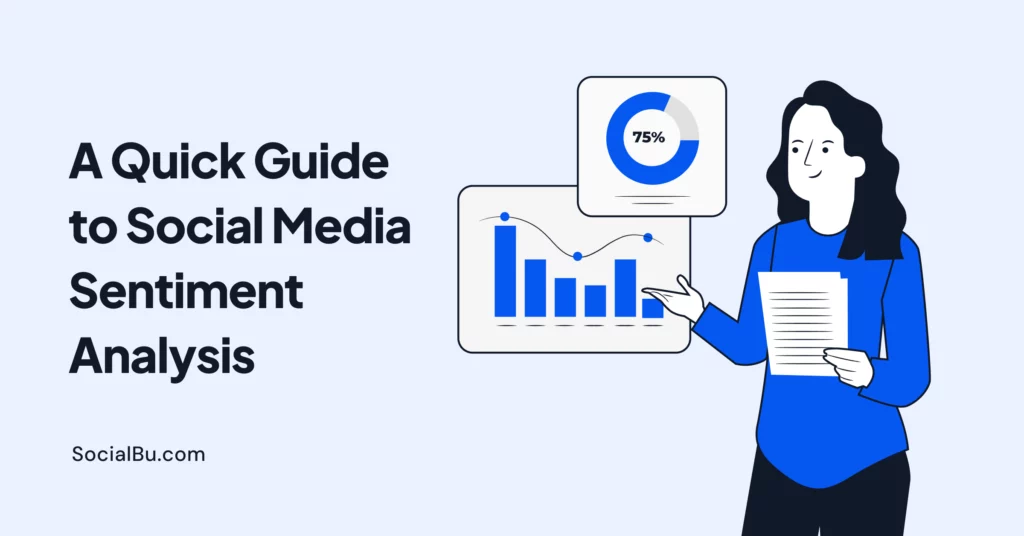Social media plays a massive role in shaping public opinion and consumer behavior in today’s digital world. People constantly share their thoughts and feelings online, whether in a tweet, a Facebook post, or an Instagram review. This is where social media sentiment analysis comes into play. It is a method for understanding people’s feelngs about a brand, product, or topic by analyzing their online posts.
Social media analytics allows businesses to track and analyze conversations across various platforms to better understand consumer perceptions. Using AI-based sentiment analysis, companies can gain insights into whether people are talking positively, negatively, or neutrally about their brand.
This guide will explore the key concepts of brand sentiment analysis, including sentiment tracking, emotion detection, and how natural language processing (NLP) and machine learning detect emotions and opinions in text. By the end, you’ll understand how businesses can use sentiment analysis to monitor their online reputation and better connect with their audience.
Without further ado, let’s learn this.
What is Social Media Sentiment Analysis?
Social media sentiment analysis analyzes online content to understand how people feel about a particular topic, brand, or product. When someone posts on social media, whether a tweet, comment, or review, they might share their thoughts and emotions, which can be positive, negative, or neutral.
Sentiment tracking measures these feelings by studying what people say online. Through Social media analytics, businesses can gather large amounts of data from platforms like Twitter, Facebook, or Instagram to see what customers say about them.
AI sentiment analysis uses Natural Language Processing (NLP) tools and machine learning to detect emotions in text automatically. These technologies help identify whether posts express happiness, anger, satisfaction, or disappointment.
Brand Sentiment Analysis
Brand sentiment analysis tells businesses whether customers feel good or bad about their brand. Emotion detection lets companies quickly determine how people react to a new product, marketing campaign, or event. Understanding these feelings can help businesses improve their products, services, and brand experience.
Types of Social Media Sentiment
Social media sentiment analysis helps businesses and brands understand how people feel about them online. By looking at social media posts, comments, and reviews, companies can see whether people are happy, upset, or neutral about their products or services.
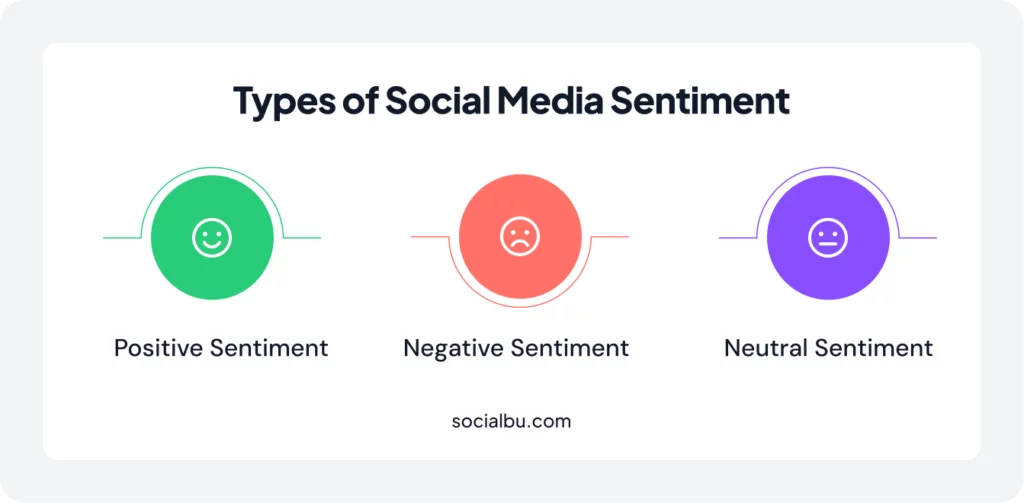
Here are some types of social media sentiment commonly seen in social media:
1. Positive Sentiment
Positive sentiment refers to emotions or opinions that express happiness, approval, or satisfaction. It is often used in brand sentiment analysis to measure how well a brand or product is performing in the eyes of its audience.
Example:
- I love this new app. It’s so easy to use, and it helps me stay organized.
- Great experience with this brand. Highly recommend it.
2. Negative Sentiment
Negative sentiment is the opposite of positive sentiment, indicating dissatisfaction, disappointment, or anger. Analyzing negative sentiment helps in sentiment tracking to understand what aspects of a product or service need improvement.
Example:
- This product didn’t work as expected. Very disappointed.
- I’m never buying from this company again. Terrible customer service.
3. Neutral Sentiment
Neutral sentiment refers to content that doesn’t express strong emotions or opinions. It’s usually informational or factual, without any positive or negative bias.
For Example:
A neutral sentiment could be used to share details about an event or announcement. Analyzing neutral sentiment helps brands in social listening by identifying non-biased content.
These three types of sentiments, positive, negative, and neutral, are essential in social media sentiment analysis.
Benefits of Social Media Sentiment Analysis
Social media sentiment analysis offers businesses powerful insights into customers’ feelings about their brand, products, or services.
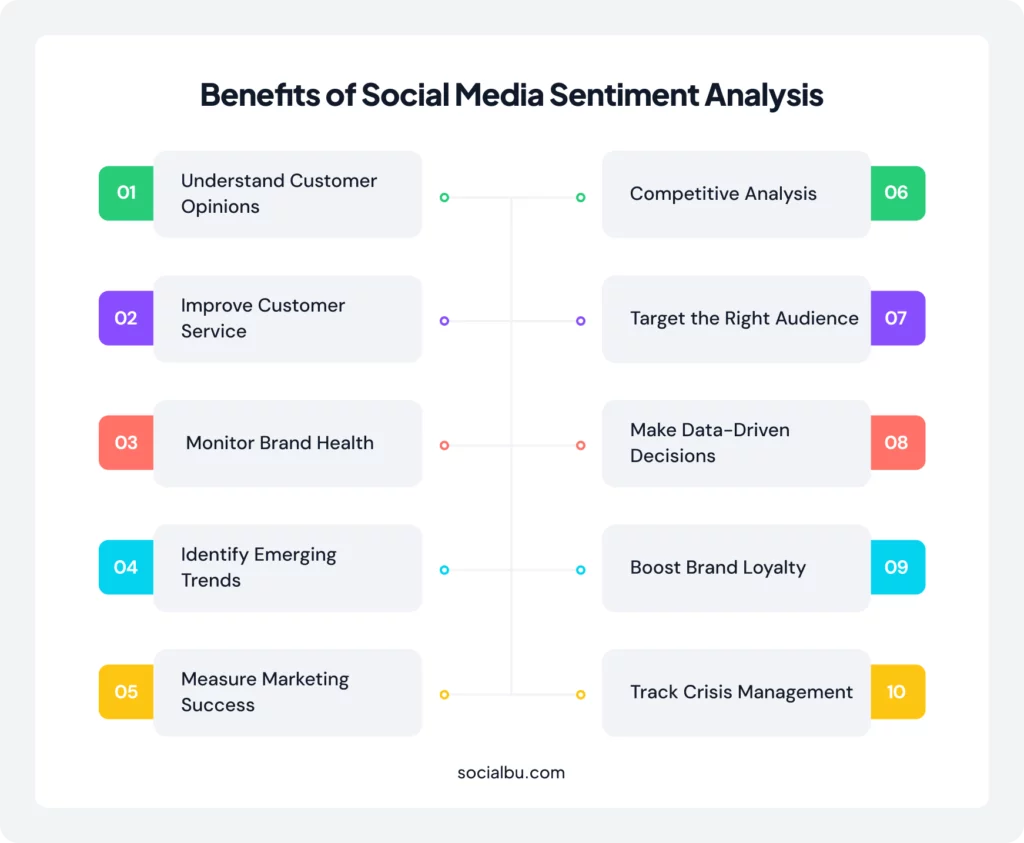
Here are the key benefits:
1. Understand Customer Opinions
It helps businesses understand how customers feel about their brand, products, or services, whether positively, negatively, or neutrally. This understanding helps companies understand what customers like or dislike so they can improve their offerings.
2. Improve Customer Service
By tracking sentiment, companies can quickly address customer complaints or issues, improving their reputation and customer satisfaction.
For example, if a customer shares a problem online, the company can respond rapidly, showing that it cares about solving issues.
3. Monitor Brand Health
It allows businesses to monitor their brand’s online reputation and detect negative trends early on. If people start talking negatively about a brand, companies can intervene before the situation worsens.
4. Identify Emerging Trends
Analyzing social media trends can help businesses spot new changes in consumer preferences, which can be used for future product development. This way, companies can stay ahead of the competition and offer what customers want.
5. Measure Marketing Success
Companies can see how their marketing campaigns are received by analyzing public sentiment and adjusting strategies accordingly. Businesses can tweak a campaign to improve the results if a campaign does not get a good reaction.
6. Competitive Analysis
Sentiment analysis helps businesses understand how their competitors are being discussed, giving them insights on improving their strategies.
7. Target the Right Audience
Businesses can target the right audience with the right message by analyzing sentiment, making their marketing more effective.
8. Make Data-Driven Decisions
It helps companies make smarter, data-backed decisions rather than relying on guesswork or assumptions. Instead of making decisions based on feelings, businesses can use the honest opinions of their customers to guide their actions.
9. Boost Brand Loyalty
Businesses can build stronger relationships and loyalty with their audience by showing customers they care about their opinions and feedback.
10. Track Crisis Management
It helps brands monitor and manage their reputations during a crisis by seeing how real-time public sentiment shifts.k
This type of analysis is valuable for businesses of all sizes. It helps them understand their audience, manage their online reputation, and improve their strategies.
Understanding Brand Sentiment Analysis
Brand sentiment analysis helps businesses understand how people feel about their brand by examining the tone and emotions behind their words. It examines online comments, reviews, social media posts, and other public mentions to determine whether people have positive, negative, or neutral feelings about the brand.
For example:
- Positive sentiment means people are happy with the brand, which could lead to more sales or brand loyalty.
- Negative sentiment means people are upset or disappointed with the brand, and businesses might need to address issues to improve their reputation.
- Neutral sentiment means people don’t have strong feelings one way or the other.
By tracking brand sentiment, businesses can spot problems early, understand what customers like or dislike, and make improvements. This helps them build better relationships with their audience and improve their products or services.
5 Best Tools for Sentiment Analysis
Here are six of the best tools for sentiment analysis, making them accessible even to those without advanced technical skills.
1. SocialBu
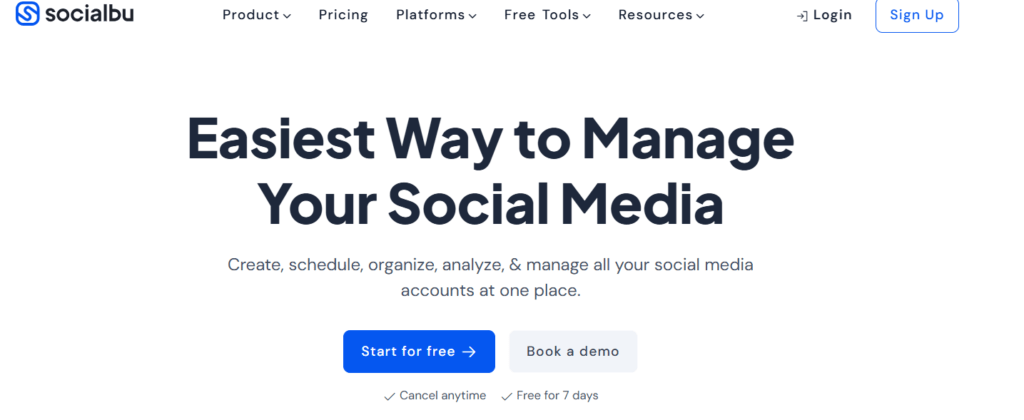
SocialBu is a tool for analyzing social media sentiment. Businesses can use it to track how people feel about their brand on social media. Using AI sentiment analysis, SocialBu automatically analyzes customer feedback from posts, comments, and reviews to detect emotions like happiness, anger, or sadness.
This allows businesses to get valuable insights into consumer sentiment and improve their online reputation management.
Key Features
1. Social Media Analytics
SocialBu provides detailed reports on sentiment and engagement metrics. It offers in-depth reports on social media activity, including how people feel about your posts and how much engagement they’re getting. It tracks likes, shares, comments, and mentions, giving you a clear picture of your online presence.
2. Brand Sentiment Analysis
This tool helps you understand how people feel about your brand by tracking whether the comments and posts are positive, negative, or neutral.
It analyzes the tone of conversations online to see if your brand is being talked about in a good or bad light. It helps you respond quickly to customer feedback, manage your reputation, and improve brand perception.
3. AI-based Sentiment Analysis
It uses machine learning and natural language processing (NLP) to analyze emotions and opinions in text.
Pricing Plans
- Free Plan: 7-Day Trial
- Standard: $19 /mo
- Super: $59 /mo
- Supreme: $199 /mo
2. Lexalytics
Lexalytics is a company that offers powerful tools for analyzing and understanding text data through Natural Language Processing (NLP). Its features are designed to help businesses make sense of large amounts of unstructured text, such as customer feedback, social media posts, and reviews.
Key Features
Here are some features of Lexalytics to make a more informed decision:
1. Sentiment Analysis
It helps you understand whether the text conveys a positive, negative, or neutral feeling. Knowing people’s feelings about a product, service, or topic is helpful.
2. Intent Detection
It helps you determine what someone is trying to say or ask, like if a customer asks for help, leaves feedback, or makes a complaint.
3. Custom Machine Learning
You can teach the system to understand your unique needs better. If you have specific challenges with text, you can create custom solutions using machine learning.
Lexalytics makes turning text into useful information easier, saving time and helping you understand what people say.
3. Brandwatch
Brandwatch is a robust monitoring and analytics platform that allows businesses to analyze deep social media sentiment. By analyzing conversations across the web and social media, Brandwatch helps companies to track positive vs. negative sentiment and gain insights into customer opinions.
Key Features
1. Competitive Analysis
By analyzing their online presence and performance, Brandwatch helps you understand how your brand compares to competitors.
2. Audience Segmentation
It groups your audience based on interests, demographics, and behavior to help tailor marketing efforts.
3. Sentiment Analysis
Brandwatch tracks the mood of online conversations, whether positive, negative, or neutral, to understand customer feelings better.
4. Campaign Tracking
It allows you to measure the success of marketing campaigns in real time and adjust strategies accordingly.
These features help businesses stay ahead of trends, understand their audience, and improve their strategies.
4. Sprout Social
Sprout Social is a social media management tool that uses AI-based sentiment analysis. It helps businesses monitor customer feedback across various platforms and detect negative sentiment before it becomes a more significant issue.
Sprout Social also enables businesses to improve social media engagement metrics by understanding how people feel about their posts and brand.
Key Features
1. Sentiment Tracking
It provides real-time insights into how audiences feel about your brand.
2. Social Media Engagement
Sprout Social tracks engagement levels and adjusts content strategy based on sentiment.
3. Brand Sentiment Analysis
It understands the emotional tone of social media posts and comments.
5. Talkwalker
Talkwalker is an innovative tool that helps businesses track what people say about them online. It looks at social media, reviews, and other online channels to understand customers’ feelings. Using advanced technology, it can pick up on small details in people’s opinions and spot trends in feedback.
Talkwalker also provides easy-to-understand visuals to help businesses make better decisions based on customer sentiment.
Key Features
1. Hashtag Sentiment Analysis
It analyzes the emotional tone of hashtags to gauge brand perception.
2. Public Opinion Analysis
Talkwalker tracks general public sentiment and opinions across social media.
3. Social Media Analytics
It also provides comprehensive metrics on brand performance and sentiment.
These tools analyze social media chats and online posts using AI, machine learning, and natural language processing (NLP). By monitoring brand sentiment, companies can understand consumer feedback, improve their online reputation management, and gain business intelligence from social data.
Comparison Table
| Tool | Best For | Ease of Use |
| Socialbu | Small to medium-sized businesses seeking affordable social media management with basic sentiment features | Beginner-friendly |
| Lexalytics | Enterprises needing advanced NLP and sentiment analysis for large datasets | Moderate to advanced |
| Brandwatch | Brands and agencies requiring comprehensive digital consumer intelligence and trend analysis | Moderate to advanced |
| Sproutsocial | Agencies and businesses managing multiple social profiles | Beginner to intermediate |
| Talkwalker | Enterprises needing real-time social listening and sentiment analysis across global markets | Moderate to advanced |
How to Integrate Sentiment Analysis Into Your Marketing Funnel
Top of Funnel (Awareness)
Use sentiment analysis to understand what prospects say about your niche’s pain points. Identify emotional triggers and tailor your content accordingly.
Middle of Funnel (Consideration)
Analyze customer conversations around competitors or alternatives. This provides leverage to position your product more favorably.
Bottom of Funnel (Decision)
Track reactions to free trials, demos, or onboarding. Quickly address hesitations and objections to drive higher conversion rates.
What KPIs Should You Track with Sentiment Analysis?
To prove business value and ROI, go beyond vanity metrics. Here are key performance indicators tied to business outcomes:
- Sentiment Score Trends (pre/post-campaign)
- Customer Satisfaction (CSAT)
- Net Promoter Score (NPS) correlations
- Crisis Response Time
- Brand Health Index
- Positive Share of Voice (SOV)
These metrics allow you to forecast revenue risk, track marketing effectiveness, and justify your investment in social media intelligence.
Social Media Sentiment Analysis Use Cases
Here are some Social Media Sentiment Analysis use cases:
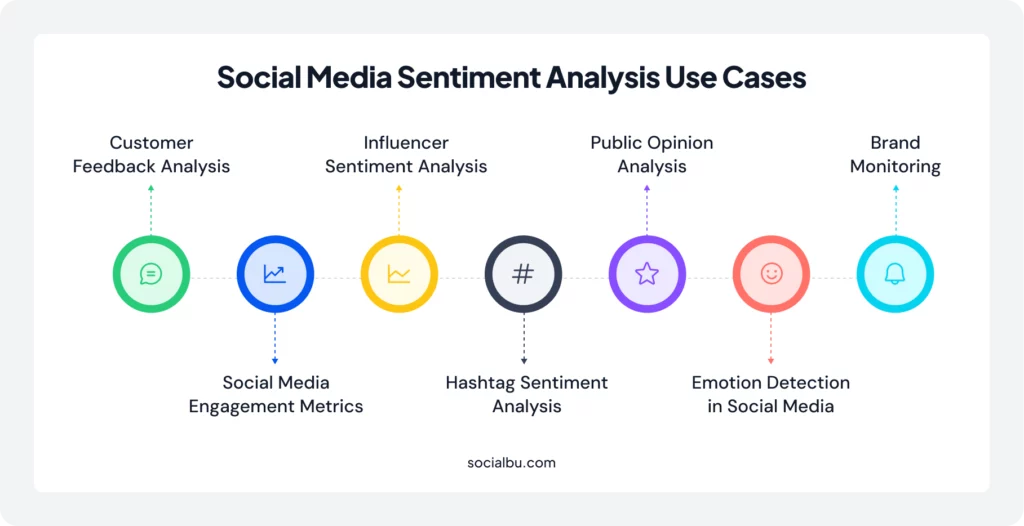
Challenges in Sentiment Analysis
Sentiment analysis, while robust, comes with several challenges that can affect its accuracy and effectiveness. Below are some of the common challenges that arise in sentiment analysis:
1. Sarcasm and Irony Detection
Sarcasm and irony can make it hard to understand the true sentiment behind a post.
For example, saying “Great job” after a mistake could be sarcastic.
Sentiment tracking tools often struggle with detecting sarcasm, which can lead to misinterpretation of positive vs. negative sentiment.
2. Context Understanding
Sentiment analysis might misclassify emotions without understanding the context of a post.
For instance, the word “sick” could mean “great” in some contexts or “ill” in others. Accurate natural language processing (NLP) is needed to determine the correct sentiment, but this is often challenging.
3. Ambiguity in Language
Words can have multiple meanings, making it difficult for sentiment analysis tools to determine the correct sentiment.
For example, “bored” could indicate sadness or a neutral state. Text analysis must address such ambiguities, which can affect the accuracy of emotion detection.
4. Handling Mixed Sentiments
Sometimes, posts express both positive and negative sentiments at once, making them hard to analyze.
For example, a post like “I love the product but hate the customer service” contains positive and negative emotions. Proper opinion mining is required to separate and identify mixed sentiments.
5. Emotion Detection Accuracy
Detecting specific emotions like joy, anger, or sadness can be tricky. While AI-based sentiment analysis can provide general insights, detecting precise emotions with high accuracy remains challenging due to the complexity of human feelings and expressions.
Conclusion
In today’s digital world, social media sentiment analysis is crucial for helping businesses understand what people think and feel. Companies can use AI sentiment analysis, natural language processing (NLP), and machine learning to gain helpful information from social media posts, reviews, and comments.
Sentiment tracking helps companies watch how people feel about their brand, products, or services, whether positive, negative, or neutral.
With social media analytics and tools like text analysis, businesses can better understand consumer sentiment, improve online reputation management, and connect more with customers.
Even though it’s powerful, emotion detection and opinion mining can have challenges like detecting sarcasm, understanding context, and dealing with mixed feelings. By using social media insights and data mining, companies can keep track of their brand monitoring, improve customer service, and build better relationships with their audience.
FAQs
Q: Does Hootsuite Do Sentiment Analysis?
Yes, Hootsuite offers sentiment analysis tools to track how people feel about your brand on social media.
Q: What Is KPI Sentiment Analysis in Social Media?
KPI sentiment analysis measures how social media conversations impact key performance indicators (KPIs) like customer satisfaction or brand reputation.
Q: Can ChatGPT do Sentiment Analysis?
Yes, ChatGPT can help with sentiment analysis by understanding if the text is positive, negative, or neutral.
Q: Can ChatGPT Analyse Text Messages?
Yes, ChatGPT can analyze text messages and determine their positive, negative, or neutral sentiments.
